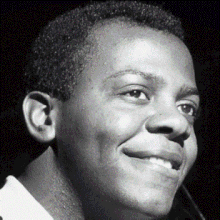Larry Young (musician)
Larry Young | |
|---|---|
 | |
| Background information | |
| Also known as | Khalid Yasin |
| Born |
October 7, 1940 Newark, New Jersey, U.S. |
| Died | March 30, 1978 (aged 37) New York City, New York, U.S. |
| Genres | |
| Occupation(s) | Musician, songwriter |
| Instrument(s) | Organ |
| Labels | Blue Note |
Larry Young (also known as Khalid Yasin [Abdul Aziz]; October 7, 1940 – March 30, 1978) was an American jazz organist and occasional pianist. Young's early work was strongly influenced by the soul jazz of Jimmy Smith, but he later pioneered a more experimental, modal approach to the Hammond B-3.
Biography
Born and raised in Newark, New Jersey, United States, Young attended Newark Arts High School, where he began performing with a vocal group and a jazz band.
Young played with various R&B bands in the 1950s, before gaining jazz experience with Jimmy Forrest, Lou Donaldson, Kenny Dorham, Hank Mobley and Tommy Turrentine. Recording as a leader for Prestige from 1960, Young made a number of soul jazz discs, Testifying, Young Blues and Groove Street. When Young signed with Blue Note around 1964, his music began to show the marked influence of John Coltrane. In this period, he produced his most enduring work. He recorded several times as part of a trio with guitarist Grant Green and drummer Elvin Jones, who were occasionally augmented by additional players. Most of these albums were released under Green's name, though Into Somethin' (with Sam Rivers on saxophone) became Young's Blue Note debut. Unity, recorded in 1965, remains his best-known album; it features a front line of Joe Henderson and the young Woody Shaw. Subsequent albums for Blue Note (Contrasts, Of Love and Peace, Heaven On Earth, Mother Ship) also drew on elements of the 1960s avant-garde and utilised local musicians from Young's hometown of Newark. Young then became a part of some of the earliest fusion groups: first on Emergency! with the Tony Williams Lifetime (with Tony Williams and John McLaughlin) and also on Miles Davis's Bitches Brew. His sound with Lifetime was made distinctive by his often very percussive approach and regular heavy use of guitar and synthesizer-like effects. He is also known for a jam he recorded with rock guitarist Jimi Hendrix, which was released after Hendrix's death on the album, Nine to the Universe.
In March 1978, he checked into a hospital for stomach pains. He died there on March 30, 1978, while being treated for what is said to be pneumonia. However, the actual cause of his death is unclear.
Discography
As leader
- Testifying (New Jazz, 1960)
- Young Blues (New Jazz, 1960)
- Groove Street (Prestige, 1962)
- Into Somethin' (Blue Note, 1965) – rec. 1964
- Unity (Blue Note, 1966) – rec. 1965
- Of Love and Peace (Blue Note, 1967) – rec. 1966
- Contrasts (Blue Note, 1968) – rec. 1967
- Heaven on Earth (Blue Note, 1969) – rec. 1968
- Lawrence of Newark (Perception, 1975) – rec. 1973
- Fuel (Arista, 1975)
- Spaceball (Arista, 1976)
- The Magician (Acanta/Bellaphon, 1977)
- Mother Ship (Blue Note, 1980) – rec. 1969. LT series.
- Larry Young in Paris: The ORTF Sessions (Resonance, 2016) - rec. 1964–65 for French radio
As sideman
|
With Miles Davis
With Grant Green
With Gildo Mahones
With John McLaughlin
With The Tony Williams Lifetime
|
With others
|